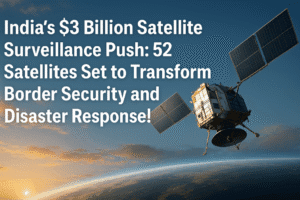India’s $3 Billion Satellite Surveillance Push: 52 Satellites Set to Transform Border Security and Disaster Response!
Following the April 2025 Pahalgam terror attack and retaliatory Operation Sindoor, India has accelerated its $3 billion Space-Based Surveillance-3 (SBS-3) initiative to deploy 52 advanced satellites by 2026—two years ahead of schedule. Designed to enhance real-time border monitoring, especially along Pakistan and China, the constellation will provide high-resolution imagery for preemptive security measures while aiding disaster response through flood and earthquake tracking.
Three private firms—Ananth Technologies, Centum Electronics, and Adani-owned Alpha Design—are leading development, leveraging expertise from past ISRO missions like Chandrayaan-3. The project underscores India’s shift toward privatizing defense-tech innovation, combining military precision with civilian applications. With potential SpaceX collaborations for timely launches, the network aims to counter regional threats and reduce dependency on foreign systems, marking a strategic leap in India’s self-reliance and global space ambitions.

India’s $3 Billion Satellite Surveillance Push: 52 Satellites Set to Transform Border Security and Disaster Response!
In response to escalating regional tensions and the aftermath of the April 2025 Pahalgam terror attack, India has fast-tracked a $3 billion initiative to deploy an advanced satellite surveillance network. Dubbed the Space-Based Surveillance-3 (SBS-3) mission, the program aims to launch 52 cutting-edge satellites by 2026—a significant acceleration from the original 2028 timeline. This push underscores India’s commitment to bolstering national security and technological self-reliance following Operation Sindoor, a targeted military strike against terror camps in Pakistan and Pakistan-occupied Kashmir (PoK) in May 2025.
Geopolitical Catalyst
The Pahalgam attack, which claimed 26 lives, and the subsequent Operation Sindoor highlighted gaps in real-time border monitoring. The SBS-3 constellation seeks to address these vulnerabilities by providing high-resolution, 24/7 surveillance of India’s borders, particularly along volatile regions with Pakistan and China. Satellite imagery from these systems will enhance intelligence gathering, enabling preemptive strikes against militant hideouts and improving response times to infiltration attempts.
Private Sector Partnership: A Strategic Shift
In a landmark move, India’s Ministry of Defence has entrusted three domestic aerospace firms—Ananth Technologies, Centum Electronics, and Alpha Design Technologies (now under Adani Defence)—with developing the satellites in just 12–18 months, slashing timelines by over 60%. These companies, veterans of ISRO collaborations, bring proven expertise:
- Ananth Technologies contributed to the Chandrayaan-3 lunar mission and is set to deliver the first SBS-3 satellite by late 2025.
- Alpha Design played a pivotal role in India’s NavIC navigation system, reducing dependency on GPS.
- Centum Electronics specializes in robust systems for extreme environments, critical for military-grade hardware.
This acceleration aligns with India’s space sector reforms, which prioritize private-sector involvement to drive innovation and scalability.
Dual-Use Technology for Civilian Benefit
Beyond defense, the SBS-3 network will revolutionize disaster management. Satellites equipped with synthetic aperture radar (SAR) can penetrate cloud cover during monsoons, enabling real-time flood tracking, while thermal imaging aids earthquake rescue operations. Such capabilities position India to meet both security and humanitarian challenges efficiently.
Strategic Implications and Global Context
The SBS-3 mission reflects a broader trend of nations leveraging space technology for defense. India’s decision to consider SpaceX for launches—alongside ISRO’s LVM3—signals pragmatism, ensuring timely deployment despite capacity constraints. Analysts note that the constellation could counterbalance China’s BeiDou surveillance network and Pakistan’s nascent space efforts, reshaping regional power dynamics.
Expert Insights
Defense analysts highlight the program’s timing as pivotal. “Post-Pahalgam, real-time intelligence is non-negotiable,” says Sameer Patil, a senior fellow at Gateway House. “The SBS-3 satellites will act as force multipliers, offering unmatched situational awareness.” Meanwhile, industry experts applaud the trust placed in private players, a shift from ISRO’s traditional government-led approach.
Challenges Ahead
Meeting the 2026 deadline requires overcoming supply chain bottlenecks and talent shortages. However, the collaboration between ISRO and private firms—bolstered by Adani’s acquisition of Alpha Design—suggests a cohesive strategy to mitigate risks.
Conclusion
India’s $3 billion surveillance push marks a transformative step in securing its borders and enhancing global strategic influence. By integrating private innovation with defense needs, the nation not addresses immediate security concerns but also lays the groundwork for a self-reliant space ecosystem. As geopolitical tensions simmer, the SBS-3 network could prove decisive in safeguarding India’s interests—both on Earth and in orbit.
You must be logged in to post a comment.